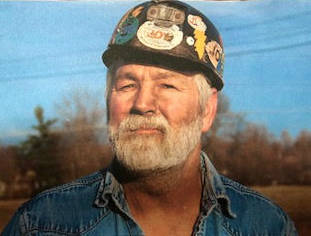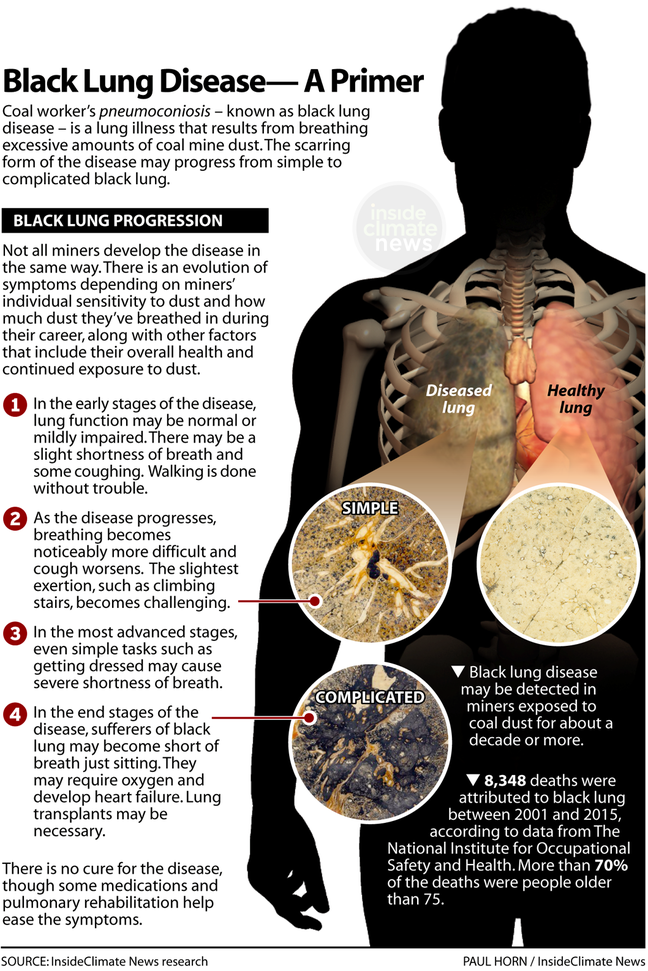Eight Black Lung Indictments Allege Coal Mine Managers Lied About Health Safety

By James Bruggers
July 11, 2018 - Michael "Flip" Wilson spent most of his adult life working deep underground in the coal mines of Western Kentucky. Now 63, he suffers so badly from black lung disease that he doesn't have the breath to play in the yard with his grandchildren.
He earned a good wage from his last employer, Armstrong Coal: $27 an hour plus bonuses and overtime—not bad for a farm kid who dropped out of school before the eighth grade, he said. But when he came forward with safety complaints, including describing how miners felt pressured to cover up the monitors they used to measure and limit their exposure to dangerous coal dust, his relationship with Armstrong turned sour.
He knew the practice well, he said, because he had done it himself.
On Wednesday, eight former supervisors and safety officials at Armstrong were charged by a federal grand jury with conspiracy to defraud federal mine safety officials from 2013 to 2015.
The indictments, announced by U.S. Attorney Russell Coleman at an Owensboro museum that tells the long history of coal mining in this part of the country, charge that the mine personnel sought to deceive regulators with the Federal Mine Safety and Health Administration (MSHA) about the daily levels of breathable dust at two mines owned by the Armstrong Coal. The company, which was based in Madisonville, Kentucky, has since gone bankrupt but was named as an unindicted co-conspirator.
"The health of our miners matters to Western Kentucky communities and those sworn to protect them," Coleman said. "When companies and their senior officials are prepared to disregard the law and put miners at risk, they should also be prepared to face federal prosecutors."
He said the indicted officials cheated and lied while avoiding the costs of ventilation and production controls, putting the company's bottom line above the health and safety of hundreds of mine workers.
The indictments were announced amid a regional resurgence of black lung, long the scourge of an industry noted for its severe health and safety risks to its workers. They also came as the Trump administration has pledged to do whatever it can to boost the ailing coal industry, which has been undercut economically by natural gas and, increasingly, by clean renewable energy sources like solar and wind.
"Armstrong should have done what they were supposed to do by the law," Wilson told InsideClimate News, adding that he expects his own black lung to cut years from his life. "I wake up all during the night, coughing and choking," he said. "I can't breathe.
"I can't hardly walk to the mailbox now," he said.

Mike Wilson
Photo courtesy of Mike Wilson
Charges of Lying on Mine Safety Tests
Coal workers' pneumoconiosis, commonly known as black lung disease or simply black lung, is caused by long-term exposure to coal dust.
U.S. Department of Justice officials on Wednesday said the charges were brought against eight former supervisory and safety officials who they said used "deceit, trickery and dishonest means" to violate mine safety rules at the Parkway Mine in Muhlenberg County and the Kronos Mine in Ohio County, both in the western Kentucky coalfield. The grand jury also charged the company officials with lying about test results in the dustiest and most dangerous job assignments in the mines.
Here's some of what the grand jury accused the officials of:
- Removing dust testing devices early in miners' shifts and placing the monitors in less dusty areas or in cleaner air.
- Improperly sending miners without dust testing devices to places where the monitors were required.
- Ordering monitors to be run in clean air before and after shifts to skew their results.
Attorneys for the eight people named in the indictments could not immediately be located for comment. The indictments carry a potential five year prison sentence and up to $250,000 in fines.
Kentucky attorney Tony Oppegard, a national expert on mine safety, said problems at the mines came to public attention after Wilson and two other miners came to him with complaints about four years ago. Their stories were published in 2014 in the Huffington Post, and Oppegard said that he sent that article to the Justice Department and that the miners testified before the grand jury. He represented the workers in related employment discrimination cases that he said have since been resolved.
Inside the Mine, 'It Was All About Production'
Brandon Shemwell, 38, is another Oppegard client who worked for Armstrong for about nine years and also reported safety violation to authorities. He's a third-generation coal miner who said he does not have black lung but has seen it devastate family members and friends.
He described working in tight underground passageways in the mines, some so short he couldn't stand up straight, and he said the company skimped on using water to keep the dust down.
Sometimes, he said, "you couldn't even see your hands in front of you."
"It was all about production, getting a ton out, more money to make," said Shemwell, who is now a truck driver. The company was "paying my bills, but when they come to safety, they were not at the top of the list at all."
Oppegard said he believes his clients are pleased by the indictments but frustrated that it took so long for criminal charges to be filed. He speculated that there could be other indictments if the Justice Department puts pressure on those who were charged Wednesday to cooperate with them and flip on their superiors.
"That's always the goal," said Coleman, the U.S. attorney. He declined to say more about the potential for more charges in the case.
Black Lung Cases Are Rising Yet Again
With black lung, it wasn't supposed to be this way anymore.
Congress in 1969 passed the Federal Coal Mine Health and Safety Act, making it national policy vanquish the disease. Later amended in 1977, It ordered safety standards, equipment and training, as well as benefits to help miners with the disease.
Black lung has been one of the most direct and personal consequences of the nation's dependence on coal, which is a major source of heat-trapping gases blamed for contributing to global warming. Since 1968, the disease has killed more than 76,000 miners and resulted in more than $45 billion in compensation benefits to coal miners disabled by black lung and their survivors.

Black lung rates had dropped from 1970 to 2010, from about 35 percent of longtime miners to about 5 percent, but they have since been on the rise, according to a new report from the National Academy of Sciences. More recently, doctors have seen pockets of more aggressive forms of the disease at hot spots in Kentucky, West Virginia and Virginia.
"The whole purpose [of the coal mine act] was to say a miner could work a 30-year career and when they retire, they could still lead a normal live," said Oppegard, who has worked in mine safety for both the federal government and state of Kentucky. "But we're actually going backward now, with all the new hot spots they are finding."
Why black lung is surging again remains unclear, but the National Academies study said it could be in part because the remaining coal seams are smaller and miners are cutting into more rock, creating a more dangerous mix of dust.
The Battles for Benefits—and for Safety Rules
In 2014, MSHA issued a rule that lowered allowable exposure limits for respirable coal mine dust and required the use of different monitoring technology aimed at reducing mine workers' dust exposure. But the National Academies report said even that rule won't be enough to protect miners. It called for a "fundamental shift ... in the way mine operators" work to eliminate black lung.
The Trump administration last year said it was reconsidering that 2014 rule as part of its effort to roll back regulations.
On July 6, MSHA announced a new study of the Obama-era rule. But at the same time, Assistant Secretary David G. Zatezalo, a former miner and coal industry executive, insisted "MSHA has no intention of rolling back the protections afforded to coal miners under the final dust rule."
Even if a miner gets diagnosed with black lung disease, there's no guarantee he or she will receive benefits they are entitled to under federal law.
InsideClimate News, as part of it Choke Hold series, described how some companies have engaged high-profile law firms that in turn employ a cadre of doctors, setting the stage for protracted battles of conflicting medical opinions. Miners, meanwhile, are often overmatched because few lawyers will take their cases. Attorneys are barred from charging plaintiffs fees, meaning they receive modest compensation, and only if they win.
For his part, Wilson, the Kentucky miner with black lung, said he's accepted his situation. "We had a good life, some great kids, great grandkids and we have great great-grandkids.
"I am living just one day at a time."
CoalZoom.com - Your Foremost Source for Coal News

